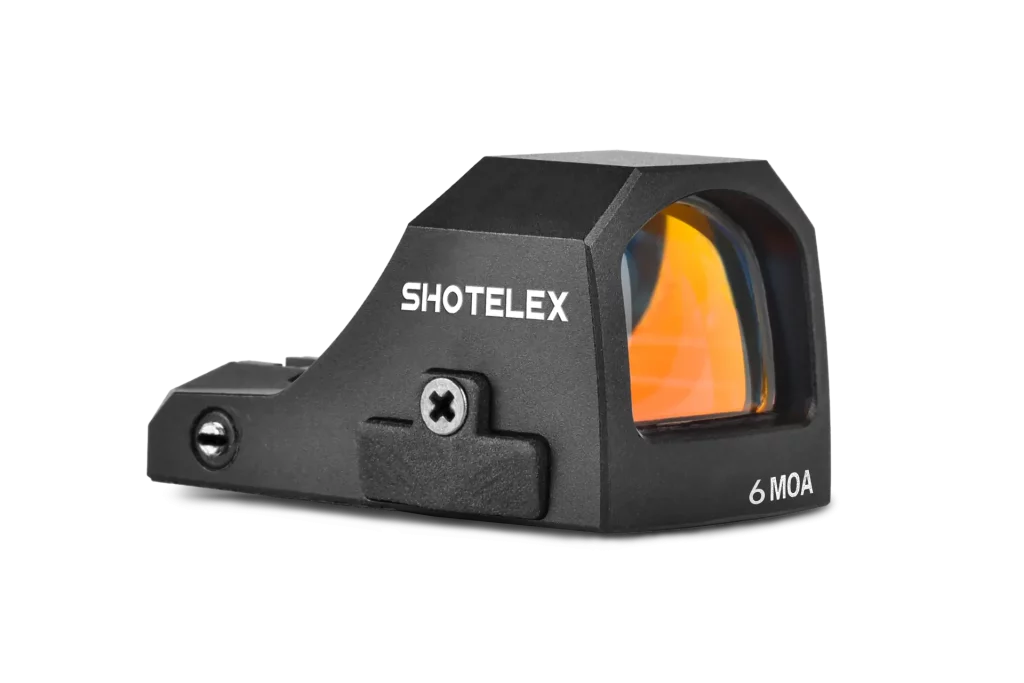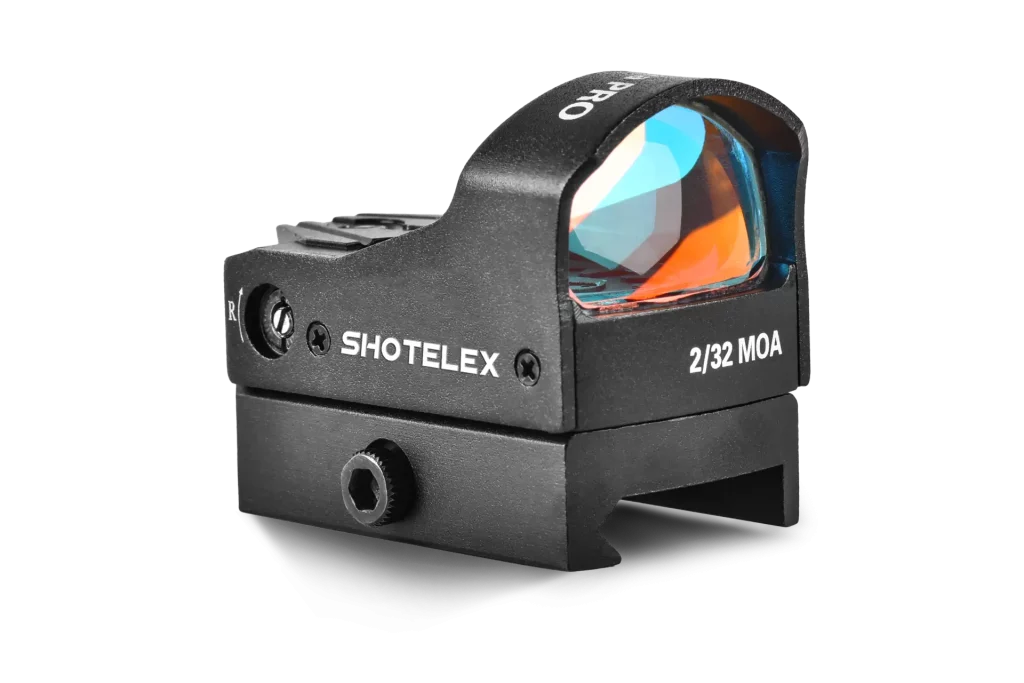Types of Red Dot Sight: How to Choose the Right One?
Red dot sights are a highly popular aiming aid in modern shooting and hunting equipment. Whether in sports shooting, hunting, or in military and law enforcement fields, red dot sights are favored for their simple aiming method and fast target acquisition.
However, there is a wide variety of red dot sights on the market. In this post, we will provide a detailed introduction to the different types of red dot sights. Let’s take a look together!
Common Types of Red Dot Sights
1. Reflex Sights
Reflex sights have an open design, usually without a tube, and the red dot is reflected onto the user’s field of view through a reflective lens. The advantage of this design is its simplicity, lightweight, and wide field of view, making it ideal for quick target acquisition.
Reflex sights often come with adjustable brightness settings to adjust the red dot’s brightness based on ambient light conditions.
- Best for: Reflex sights are perfect for quick shooting, such as handguns, rifle shooting, and hunting.
- Advantages: Lightweight, simple design, quick target acquisition.
- Disadvantages: May have glare in strong sunlight.

Recommended Reflex Sight: Shotelex Jaguar Reflex Sight 1X22X16
As a reliable reflex sight supplier, Shotelex specializes in high-quality optics. Its Jaguar Reflex Sight 1X22X16 is a top-performing red dot sight, equipped with advanced features, making it ideal for a wide range of firearms, including pistols, ARs, and shotguns.
Key Features:
- Motion Activation Technology: Automatically activates the sight, saving battery life and reducing frequent replacements.
- Waterproof: Reliable in all weather conditions, making it ideal for outdoor use.
- Versatile Compatibility: Works with pistols, ARs, and shotguns, ensuring accuracy across different firearms.
- 7 Brightness Settings: Offers 6 daytime modes and 1 night vision mode, adapting to various lighting conditions.
- Low-Light and Night Vision: Supports night vision equipment for effective use in low-light or nighttime conditions.

2. Tube Sights
Tube sights have a closed design, similar to small telescopic sights, where the red dot is projected through a tube. These sights are typically more stable and offer better dust and water resistance.
While the field of view is narrower compared to reflex sights, tube sights offer more stability and are ideal for tactical shooting or harsh environments.
- Best for: Tube sights are commonly used in tactical shooting, military, and police applications and are excellent for use in harsh conditions.
- Advantages: Stable, waterproof, dustproof.
- Disadvantages: Narrower field of view, heavier than reflex sights.
3. Prism Sights
Prism sights use optical lenses with magnification, providing greater precision for long-range shooting. These sights are compact and provide clear visuals, even at high magnifications, without losing accuracy. Unlike reflex sights, prism sights offer a clearer field of view, making them suitable for precise aiming.
- Best for: Ideal for precision shooting, such as sniper rifles and long-range shooting.
- Advantages: Provides higher accuracy and magnification, suitable for precise shots.
- Disadvantages: Generally bulkier and heavier.

4. Circle Dot Sights
Circle dot sights combine a small red dot with a circle surrounding it. The circle helps users quickly acquire the target, while the central red dot allows for precise aiming. This design is particularly useful for dynamic shooting scenarios, allowing users to quickly lock onto targets and accurately shoot.
- Best for: Quick shooting and dynamic shooting, especially for close to medium-range shooting.
- Advantages: Fast target acquisition, suitable for dynamic shooting.
- Disadvantages: May not be as precise as traditional sights for long-range shooting.
5. Adjustable Brightness Red Dot Sights
These sights feature adjustable brightness controls, allowing users to customize the red dot’s brightness according to different lighting conditions. This makes them ideal for various environments, from low-light indoor settings to bright, outdoor shooting.
- Best for: Ideal for changing lighting conditions, such as hunting or outdoor shooting.
- Advantages: Brightness can be adjusted to suit different lighting conditions.
- Disadvantages: Requires frequent adjustments, and battery life may be affected.
Why Use a Red Dot Sight?
1. Fast Target Acquisition
Red dot sights provide quick and easy target acquisition. The illuminated reticle (the red dot) allows you to instantly align your sight with the target, reducing aiming time and improving shooting speed.
2. Enhanced Accuracy
Unlike traditional iron sights, red dot sights allow you to focus on the target rather than the sights, which can lead to more accurate shots, especially at longer distances or under pressure.
3. Improved Field of View
Most red dot sights have an open or reflex design, offering a wide field of view. This helps you maintain awareness of your surroundings and track moving targets more easily.

4. Versatility
Red dot sights are versatile and can be used on a wide range of firearms, including handguns, rifles, shotguns, and even bows. They are also ideal for various shooting activities, such as hunting, tactical operations, and competitive shooting.
5. Reduced Eye Strain
Unlike traditional iron sights, red dot sights don’t require you to align the front and rear sights. This makes them more comfortable for extended shooting sessions and helps reduce eye strain.
How to Choose the Right Red Dot Sights?
Choosing the right red dot sight can significantly enhance your shooting experience. When choosing the right red dot sight, you can consider the following aspects:
1. Purpose of Red Dot Sight
First and foremost, you should consider the primary use for the red dot sight. Here’s a quick breakdown of red dot sights based on different purposes:
- Hunting: Reflex or tube sights are ideal for quick target acquisition in varied environments.
- Tactical/Police Use: Tube sights are better for durability and reliability in harsh conditions.
- Sport Shooting: Reflex or circle-dot sights work well for fast aiming and close-range shooting.
- Long-Range Shooting: Prism or tube sights with magnification offer more precision.
2. Reticle Type and Size
The reticle, or the “dot” itself, comes in different shapes and sizes. The size and type of reticle can impact your aiming speed and accuracy. Some factors to keep in mind:
- Dot Size: Red dot sights offer various dot sizes (e.g., 1 MOA, 2 MOA, 4 MOA). A smaller dot (1 MOA) provides more precision for long-range shots, while a larger dot (3-4 MOA) allows for quicker target acquisition at closer ranges.
- Circle Dot vs. Simple Dot: Some sights offer a circle with a dot in the middle, which can make acquisition faster in dynamic situations. Others offer just one dot for a more precise aiming experience.
3. Field of View (FOV)
Field of view (FOV) refers to the size of the area visible through sight. A wider FOV allows you to see more of the surrounding area, which is useful for tracking fast-moving targets.
- Reflex sights tend to offer the widest field of view, making them ideal for quick target acquisition in close-range scenarios.
- Tube sights typically offer a more focused field of view, which may be better for long-range shots where precision matters.

4. Durability and Build Quality
When selecting a red dot sight, durability is critical. You want a sight that can withstand the rigors of your specific shooting environment.
- Waterproof and Shockproof: Look for red dot sights that are waterproof and shockproof, especially if you plan on using them in harsh weather or in military/tactical conditions.
- Material: The material of the housing should be robust, with options like aluminum or titanium being common in high-quality models. These materials are resistant to damage and wear.
5. Battery Life
Battery life is another important consideration. A long battery life, especially for tactical or hunting scenarios where you don’t want to worry about the battery dying during use.
- Adjustable Brightness: Red dot sights that allow you to adjust the brightness based on the surrounding lighting conditions can extend battery life, as you can reduce the intensity of the dot when not in bright light.
- Auto Shut-off: Some sights have an automatic shut-off feature that turns off the red dot after a set period of inactivity, saving battery life.
6. Parallax-Free and Eye Relief
- Parallax-Free: Many red dot sights are parallax-free at a specific distance (usually 50 yards). This means that the dot stays on the target regardless of where you position your eye, making it easier to aim quickly and accurately.
- Eye Relief: Red dot sights generally offer unlimited eye relief, meaning you can maintain a comfortable distance from the sight while still being able to see the dot clearly. However, for long-range shooting, you may want to ensure that the sight provides sufficient eye relief for comfortable viewing.
Final Thoughts
There are various types of red dot sights, and the choice of which one to use mainly depends on your specific needs. We hope that by reading this article, you’ll have a clearer understanding of red dot sights and the key factors to consider when making your selection. If you’re looking for a high-quality reflex sight, Shotelex red dot sight supplier is the ideal choice for you.








